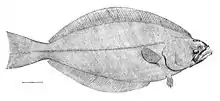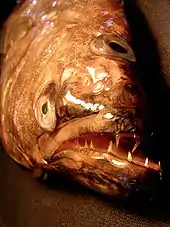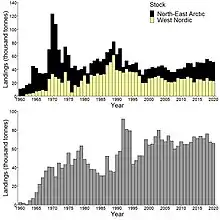Greenland halibut
The Greenland halibut or Greenland turbot (Reinhardtius hippoglossoides) belongs to the family Pleuronectidae (the right-eye flounders), and is the only species of the genus Reinhardtius. It is a predatory fish that mostly ranges at depths between 500 and 1,000 m (1,600–3,300 ft), and is found in the cold northern Atlantic, northern Pacific, and Arctic Oceans.[2]
| Greenland halibut | |
|---|---|
 | |
| Scientific classification | |
| Domain: | Eukaryota |
| Kingdom: | Animalia |
| Phylum: | Chordata |
| Class: | Actinopterygii |
| Order: | Pleuronectiformes |
| Family: | Pleuronectidae |
| Genus: | Reinhardtius Gill, 1861 |
| Species: | R. hippoglossoides |
| Binomial name | |
| Reinhardtius hippoglossoides (Walbaum, 1792) | |
| Synonyms[2] | |
| |
It has a variety of other English vernacular names, including black halibut, blue halibut, lesser halibut, and Newfoundland turbot;[3] while both Newfoundland turbot and Greenland turbot are in common use in North America (sometimes even without the location, just "turbot"), these names are typically not used in Europe, where they can cause easy confusion with the true turbot (Scophthalmus maximus).[4]
The Greenland halibut is fished commercially across its range with disputes over the fishing rights for this species in the Atlantic Ocean off Canada resulting in the Turbot War of the mid-1990s (a "war" without any injuries or casualties).[5]
The Greenland halibut is a flatfish, and the left eye has migrated during the fish's development so that it is on the right side of the head. However, in this fish, it has not moved as far as in bottom-dwelling flatfish and the fish can probably see forwards. The Greenland halibut can swim in a vertical position and both sides of its body are a speckled brown colour, but the left side is rather paler than the right.
The Hellefisk Fjord in Greenland is named after this fish, hellefisk being the Danish name for Greenland halibut.
Description
Its morphology with the left eye positioned on the dorsal ridge of the forehead gives it an appearance of a cyclops when looking straight at it. The central position of the left eye in the Greenland halibut probably gives it a much wider range of peripheral vision in comparison to other flatfish, where the eye has migrated completely. Its body shape is elongated and compressed dorsoventrally and muscles on both sides are equally developed. Both sides are pigmented, but the left blind side is slightly lighter in color than the right side. The maximum length is about 120 cm (3.9 ft) and the maximum weight is about 45 kg (99 lb), the normal length is 80–100 cm (2.6–3.3 ft) and they usually weigh 11–25 kg (24–55 lb).[3]
Distribution and habitat
The Greenland halibut is a cold-water species found at depths from near the surface to 2,200 m (7,200 ft), but mainly between 500 and 1,000 m (1,600 and 3,300 ft).[2] It is mainly found in waters with temperatures from 1 to 4 °C (34–39 °F), but has also been observed at subzero temperatures down to −2.1 °C (28.2 °F). It has a circumpolar distribution in the Northern Hemisphere and is found in both the North Atlantic and the North Pacific Oceans. In the North Pacific, it ranges from the Sea of Japan near Honshu northwards to the Chukchi Sea, east through the Aleutian Islands, and south as far as northern Baja California in Mexico.[2] In the North Atlantic, it occurs from the British Isles to northern Norway, Faroe Islands, Iceland, and eastern Greenland in the east and from Newfoundland to northwestern Greenland in the west.[3]
Biology

As a species of flatfish, it is presumed that this fish would be primarily associated with the seabed, however, tagging information shows that they spend time both close to the seabed and with frequent excursions into the water column, presumably for feeding.[6][7] These movements up into the water column explain why it is often caught pelagically. It has been speculated that when in the water column they will swim in a vertical position, but data from data storage tags do not support this hypothesis.[8]
Greenland halibut consumes prey from demersal and pelagic habitats and is primarily a piscivore. It also feeds upon a variety of other prey items such as amphipods and shrimps. In the north-east Arctic, squid and fish such as Atlantic herring, capelin and Atlantic cod are important components of their diet, with squid making up a greater component of the diet of smaller individuals.[9] In the Beaufort Sea, polar cod and Gelatinous Snailfish are important prey items[10] while in the shrimp grounds of west Greenland, shrimp and redfish are the primary prey.[11] They are known to feed on significant quantities of offal discarded from fishing vessels.[9]
Greenland halibut spawn from January–March.[7][12] During spawning, Greenland halibut will perform spawning rises where they will rise up through the water column from deep water to depths of around 200–350 m where they will release their eggs and sperm before descending back to deeper water.[7] Females will release one batch of eggs each year after while the males will spawn with multiple females over the course of the spawning season. The eggs and larvae remain suspended in the water column throughout development and complete their metamorphosis on attaining a length of 6–8.5 cm (2.4–3.3 in)
Greenland halibut have an unusual form of gonad development in comparison with many other fish species. They will develop two groups of oocytes concurrently, one group will be spawned in the current spawning cycle, the other will be spawned in the next spawning cycle. The reason for this is due to the large eggs (2.5-3.0 mm in diameter) and the cold water in which they in habit, it takes more than 1 year for oocytes to complete vitellogenesis. If they were to develop one group of oocytes at a time, they would only be able to spawn every two years.[12]
Fishing and conservation
Greenland halibut are fished commercially by several countries including Russia, Norway, Iceland, Germany, Spain, Greenland and Canada and are caught using a variety of gears including bottom trawls, longline and gillnets. Reported landings have been around 50-140 thousand metric tonnes per year since 1960. Fishing is the most important industry in Greenland and Greenland halibut is the second-most important species (after northern prawn), meaning that any changes can have a significant effect on the country's overall economy,[13] as well as the local economy as most inshore fisheries involve small-scale, small-boat fishers.[14] Similarly, the fishery for Greenland halibut is very important to some First Nations and Inuit communities in Canada.[15]
The species is not threatened overall and it can be locally abundant, but it is near threatened. Until the 1970s, the species declined due to overfishing, but since the 1980s, an overall slight increase has been seen, although some local populations have further declined.[1] The primary threat is overfishing. Secondary threats are related to their deep-water spawning grounds. Some are in areas with oil and gas extraction.[15] Others spawning grounds are in deep near-shore regions where the ecosystem relies on nutrients from meltwater from glaciers, but these are gradually disappearing.[16]
In 2010, Greenpeace International added the Greenland halibut to its seafood red list because some fishing for the Greenland halibut is by bottom trawl, which can cause significant environmental damage, and some populations appear to be overfished.[17] In coastal regions and some offshore regions, fishing for Greenland halibut mainly is done by deep-sea long line fishing (out of reach of seabirds and too cold for sea turtles, issues for this fishing type elsewhere in shallower and warmer waters) and stationary bottom gillnets, which does not cause the same damage as bottom trawling.[18] In 2017, the Marine Stewardship Council certified that the fishery for Greenland halibut was sustainable.[19][20] Because Canada and Greenland share the offshore populations in the Davis Strait–Baffin Bay region in between them, the two have shared the fishing quota and follow the same guidelines in this region.[21] Offshore populations in this region are healthy, stable and well-managed, but in more coastal areas some populations have fallen due to overfishing, although they do get a regular input of young fish from the stable offshore populations.[18][21] Deals on fishing quotas for offshore fishing for Greenland halibut and other species have also been reached between Greenland, Faroe Islands, Norway, and Russia.[22] Among well-monitored populations, the ones in the East Greenland–Iceland region (i.e., Greenland Sea, Denmark Strait and nearby) experienced the greatest decline since the 1970s.[1] In 2019, the parties agreed on a reduction of fishing for Greenland halibut in the Greenland Sea region, following recommendations by biologists.[23][24] In some inshore waters of Greenland, fishing quotas for Greenland halibut have been temporarily raised several times, contrary to recommendations by fisheries biologists, and leading to recommendations of a clearer separation of decisions on quotas and the Greenlandic Government (decisions not fully left to Greenland's Fisheries Commission).[25][26][27] A smaller fishery for the species also exists in the Gulf of Alaska (where relatively uncommon) and the Bering Sea region (where more common), and these populations are not overfished.[28]
The oil-rich, soft meat is regarded as good, but inferior to that of the Atlantic halibut and European turbot. Traditionally, it was salted, but today it is mostly smoked or frozen and the primary market is in East Asia, where it is regarded as a delicacy.[3][29] However, because of the thick skin, high fat content, and low meat yield, as much as one-third of the fish can be lost in production.[30] In Greenland, the remains are often used as food for the sled dogs (Greenland dogs).[31]
References
- Munroe, T.; Costa, M.; Nielsen, J.; Herrera, J. & de Sola, L. (2015). "Reinhardtius hippoglossoides". IUCN Red List of Threatened Species. 2015: e.T18227054A45790364. Retrieved 26 March 2018.
- Froese, Rainer; Pauly, Daniel (eds.) (2018). "Reinhardtius hippoglossoides" in FishBase. February 2018 version.
- "Reinhardtius hippoglossoides (Walbaum, 1792)". FAO Specie Factsheets. Food and Agriculture Organization Fisheries and Aquaculture Department. Retrieved 26 March 2018.
- Dyck, M.; P. H. Warkentin; M. A. Treble (2007). "A Bibliography on Greenland Halibut, Reinhardtius Hippoglossoides (a.k.a. Greenland Turbot) 1936-2005" (PDF). Canadian Technical Report of Fisheries and Aquatic Sciences 2683. Fisheries and Oceans Canada.
- Stephens, T. (2009). International Courts and Environmental Protection. Cambridge University Press. pp. 212–214. ISBN 978-0-521-88122-7.
- Boje, J; Neuenfeldt, S; Sparrevohn, Cr; Eigaard, O; Behrens, Jw (2014-08-04). "Seasonal migration, vertical activity, and winter temperature experience of Greenland halibut Reinhardtius hippoglossoides in West Greenland waters". Marine Ecology Progress Series. 508: 211–222. doi:10.3354/meps10874. ISSN 0171-8630.
- Siwicke, Kevin A.; Seitz, Andrew C.; Rodgveller, Cara J.; Echave, Katy B. (2022-02-16). "Characterizing spawning behavior of Greenland halibut (Reinhardtius hippoglossoides) in the eastern Bering Sea and Aleutian Islands". Fishery Bulletin. 120 (1): 55–67. doi:10.7755/FB.120.1.5.
- Albert, Ole Thomas; Lambert, Yvan; Vollen, Tone; Freitas, Carla; Heggebakken, Lise (2012). "Distinguishing pelagic and demersal swimming of deepwater flatfish by recording of body angles". Advances in Fish Tagging and Marking Technology. doi:10.47886/9781934874271.ch34.
- Hovde, S (April 2002). "Spatial, seasonal and ontogenetic variation in diet of Northeast Arctic Greenland halibut (Reinhardtius hippoglossoides )". ICES Journal of Marine Science. 59 (2): 421–437. doi:10.1006/jmsc.2002.1171.
- Giraldo, Carolina; Stasko, Ashley; Walkusz, Wojciech; Majewski, Andrew; Rosenberg, Bruno; Power, Michael; Swanson, Heidi; Reist, James D. (July 2018). "Feeding of Greenland halibut (Reinhardtius hippoglossoides) in the Canadian Beaufort Sea". Journal of Marine Systems. 183: 32–41. doi:10.1016/j.jmarsys.2018.03.009. S2CID 134616507.
- Pedersen, S (November 1993). "Feeding habits of redfish (Sebastes spp.) and Greenland halibut (Reinhardtius hippoglossoides) in West Greenland waters". ICES Journal of Marine Science. 50 (4): 445–459. doi:10.1006/jmsc.1993.1048.
- Kennedy, James; Gundersen, Agnes C.; Høines, Åge S.; Kjesbu, Olav S. (2011). "Greenland halibut (Reinhardtius hippoglossoides) spawn annually but successive cohorts of oocytes develop over 2 years, complicating correct assessment of maturity". Canadian Journal of Fisheries and Aquatic Sciences. 68 (2): 201–209. doi:10.1139/F10-149. ISSN 0706-652X.
- "De grønlandske hellefisk er i dramatisk tilbagegang". WWF. 24 August 2017. Retrieved 22 December 2019.
- "Situationen på verdensmarkedet for hellefisk". Royal Greenland. 27 June 2015. Retrieved 22 December 2019.
- "Canada's Arctic Marine Atlas" (PDF). Ottawa, Ontario: Oceans North Conservation Society. 2018. Retrieved 22 December 2019.
- "Glaciers are vital for Greenland's fisheries". ScienceNordic. 1 September 2017. Retrieved 22 December 2019.
- Greenpeace International Seafood Red list
- "Helleflynder". WWF. 3 May 2016. Retrieved 22 December 2019.
- "Arctic Greenland halibut certified as sustainable". Marine Stewardship Council. 31 October 2017. Retrieved 26 March 2018.
- "Greenland halibut". Marine Stewardship Council. 19 October 2017. Retrieved 22 December 2019.
- "De udenskærs hellefisk har det godt". Kalaallit Nunaata Radioa (Greenlandic Broadcasting Corporation). 29 June 2018. Retrieved 22 December 2019.
- "Fiskeriaftale med Norge er i hus". Kalaallit Nunaata Radioa (Greenlandic Broadcasting Corporation). 10 December 2015. Retrieved 22 December 2019.
- "Fiskeriaftale med Rusland indgået for næste år". Kalaallit Nunaata Radioa (Greenlandic Broadcasting Corporation). 5 December 2019. Retrieved 22 December 2019.
- "Aftale om fiskeri med Norge er underskrevet". Kalaallit Nunaata Radioa (Greenlandic Broadcasting Corporation). 12 December 2019. Retrieved 22 December 2019.
- "Uummannaq-fiskere må fiske flere hellefisk". Kalaallit Nunaata Radioa (Greenlandic Broadcasting Corporation). 26 November 2019. Retrieved 22 December 2019.
- "Naalakkersuisut hæver kvote til det dobbelte af biologers anbefaling". Kalaallit Nunaata Radioa (Greenlandic Broadcasting Corporation). 18 December 2019. Retrieved 22 December 2019.
- "Immanuelsen: Det er op til politikerne at vurdere kvotetildeling". Kalaallit Nunaata Radioa (Greenlandic Broadcasting Corporation). 18 December 2019. Retrieved 22 December 2019.
- "Greenland Turbut". NOAA Fisheries. 3 May 2016. Retrieved 22 December 2019.
- Nuttall, M., ed. (2005). Encyclopedia of the Arctic. Routledge. pp. 785–786. ISBN 0-203-99785-9.
- "Greenland Halibut". Scottish Government. Retrieved 26 March 2018.
- "Fodring af slædehunde" (PDF). Dyrlægeembedet i Ilulissat [Veterinary office in Ilulissat]. Retrieved 22 December 2019.

